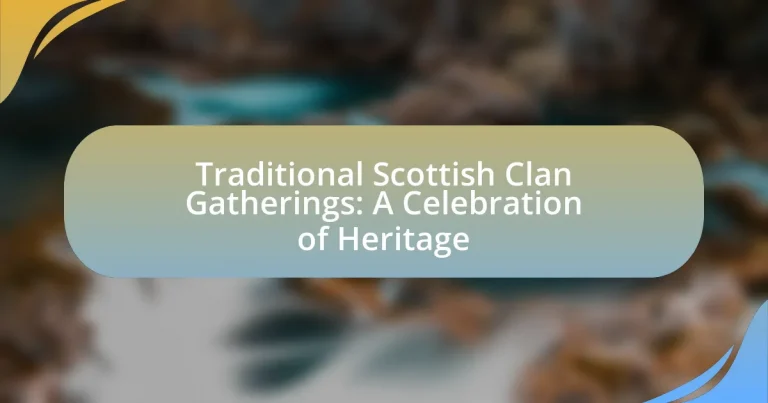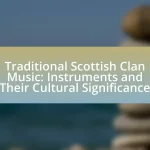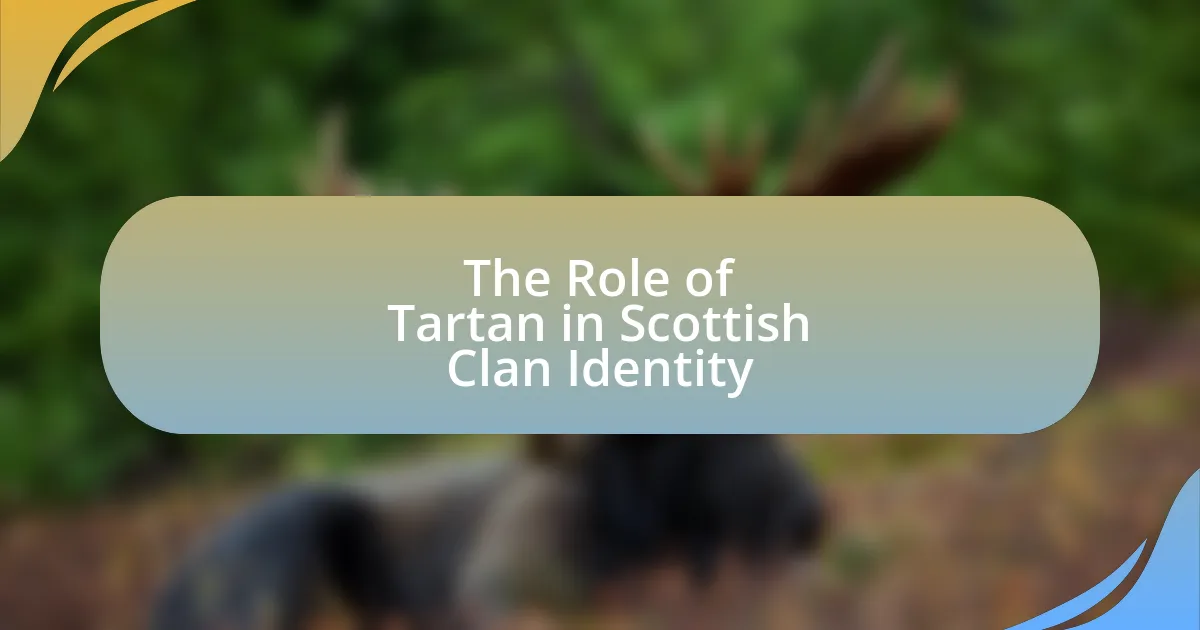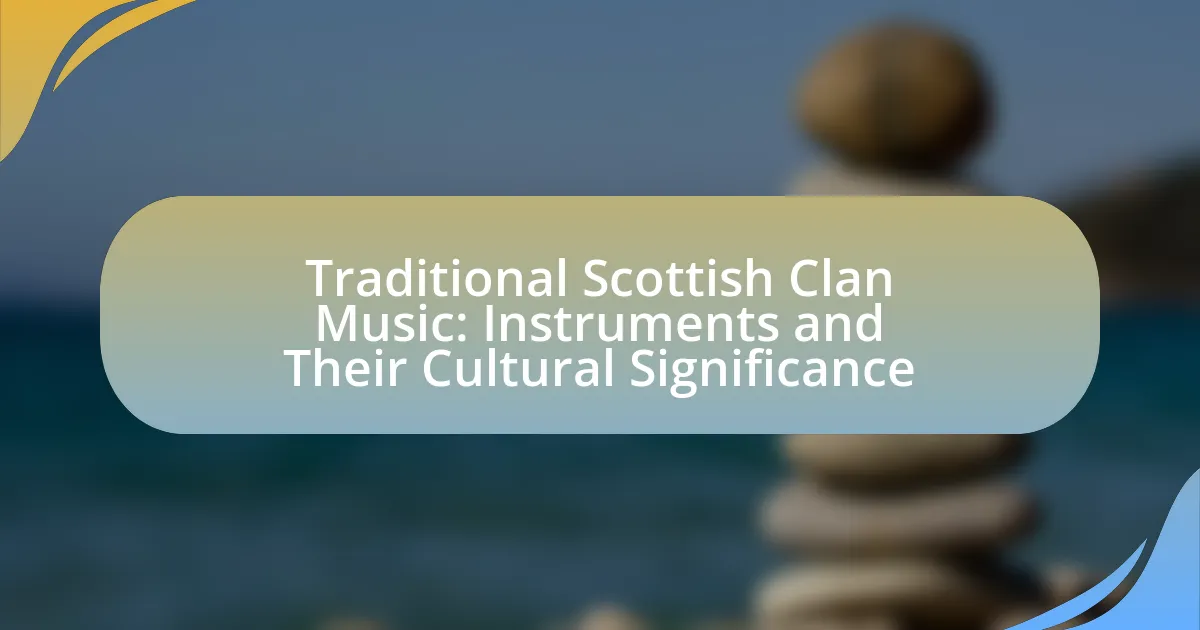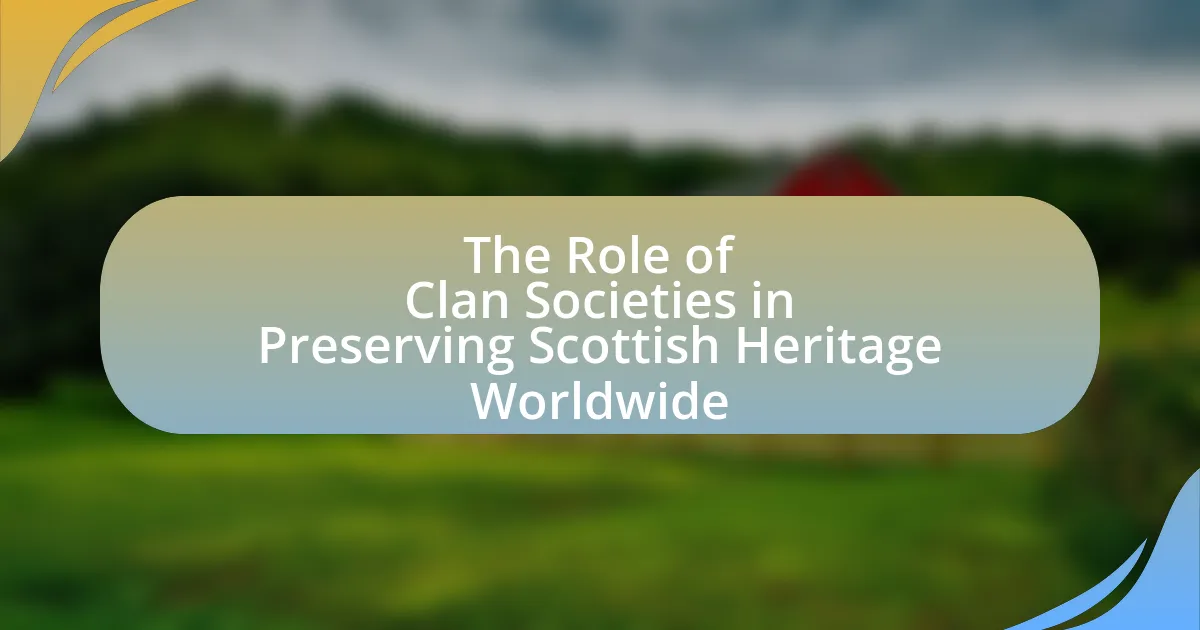Traditional Scottish Clan Gatherings are significant events where members of specific clans unite to celebrate their shared heritage, culture, and history. Originating from medieval times and formalized in the 19th century, these gatherings include traditional music, dance, storytelling, and athletic competitions, reinforcing clan identity and community bonds. Influenced by historical events such as the Jacobite uprisings, these gatherings have evolved to focus on cultural celebration while preserving Scottish traditions. Key elements include parades, competitions, and ceremonies that honor clan history, with clan societies playing a vital role in organizing these events. Participants can engage by attending gatherings, wearing traditional attire, and respecting clan customs, thereby fostering a sense of belonging and cultural pride.
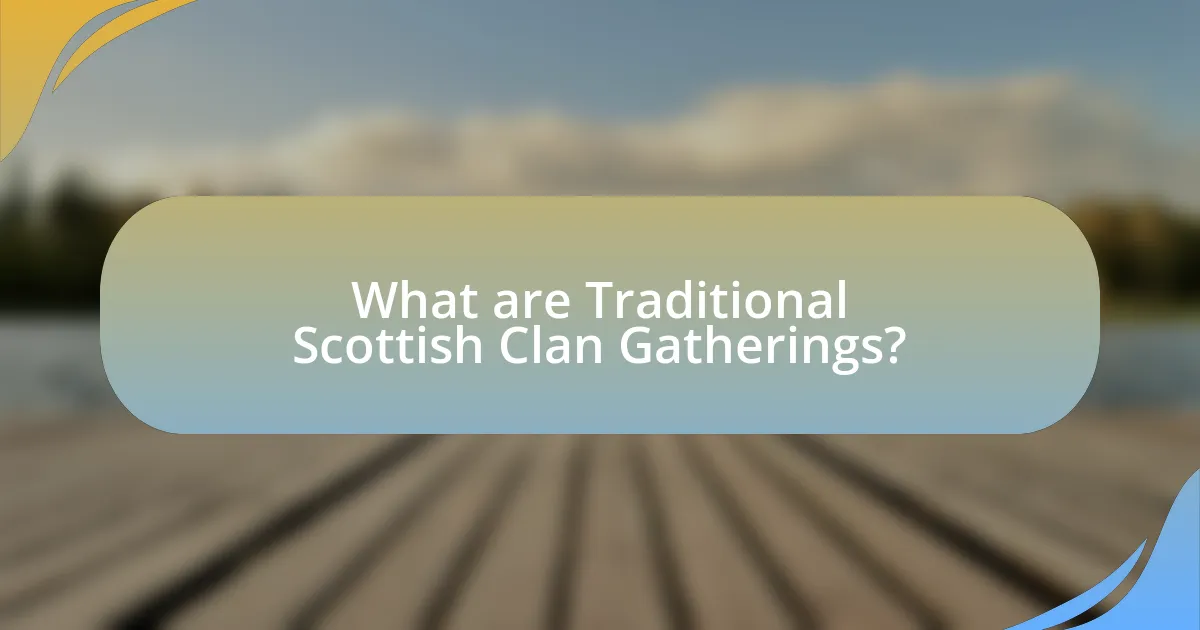
What are Traditional Scottish Clan Gatherings?
Traditional Scottish Clan Gatherings are events where members of a specific clan come together to celebrate their shared heritage, culture, and history. These gatherings often include activities such as traditional music, dancing, storytelling, and athletic competitions, fostering a sense of community and belonging among clan members. Historically, these events have served as a means to reinforce clan identity and solidarity, with roots tracing back to the 19th century when clans began to organize formal reunions. The significance of these gatherings is underscored by their role in preserving Scottish traditions and promoting cultural pride among descendants of Scottish clans.
How did Traditional Scottish Clan Gatherings originate?
Traditional Scottish Clan Gatherings originated as a means for clans to unite, strengthen bonds, and celebrate their shared heritage. These gatherings can be traced back to the medieval period when clans, often led by a chief, would come together for various purposes, including military alliances, social events, and the reinforcement of clan identity. Historical records indicate that such gatherings became more formalized in the 19th century, particularly during the Highland Games, which showcased traditional sports, music, and dance, further solidifying clan connections and cultural pride.
What historical events influenced the formation of these gatherings?
The formation of traditional Scottish clan gatherings was significantly influenced by the Jacobite uprisings of the 17th and 18th centuries. These uprisings, particularly the 1745 rebellion led by Charles Edward Stuart, aimed to restore the Stuart monarchy and fostered a sense of unity among clans. Following the uprisings, the British government enacted the Disarming Act of 1746, which prohibited the wearing of tartan and the carrying of weapons, leading clans to seek alternative ways to preserve their identity and heritage. Consequently, clan gatherings emerged as a means to celebrate cultural traditions, maintain clan ties, and assert their identity in the face of suppression.
How have clan gatherings evolved over time?
Clan gatherings have evolved from primarily military and political assemblies in medieval Scotland to modern celebrations of heritage and community. Historically, these gatherings served as opportunities for clans to unite for defense, negotiate alliances, and settle disputes, often marked by rituals and ceremonies that reinforced clan identity. Over time, particularly from the 19th century onwards, the focus shifted towards cultural celebration, with events featuring traditional music, dance, and games, reflecting a broader interest in Scottish heritage. This transformation is evidenced by the establishment of events like the Highland Games, which began in the 19th century and continue to attract participants and spectators globally, showcasing the enduring legacy of clan culture while adapting to contemporary values of inclusivity and celebration of diversity.
Why are Traditional Scottish Clan Gatherings significant?
Traditional Scottish Clan Gatherings are significant because they serve as a vital expression of cultural identity and heritage for Scottish clans. These gatherings foster a sense of community among clan members, allowing them to reconnect with their ancestral roots and traditions. Historically, clan gatherings have been a platform for celebrating shared history, showcasing traditional music, dance, and customs, which reinforces clan solidarity. Additionally, events such as the Clan Gathering at the Edinburgh Castle, which dates back to the 12th century, highlight the importance of these gatherings in preserving Scottish history and promoting cultural pride.
What role do these gatherings play in preserving Scottish heritage?
Traditional Scottish clan gatherings play a crucial role in preserving Scottish heritage by fostering a sense of identity and community among participants. These events celebrate cultural traditions, including music, dance, and storytelling, which are integral to Scottish history. For instance, the annual Clan Gathering at the Highland Games showcases traditional Scottish sports and encourages the transmission of ancestral knowledge, thereby reinforcing cultural continuity. Additionally, these gatherings often include ceremonies that honor clan history and lineage, ensuring that the stories and values of past generations are passed down to future ones.
How do clan gatherings foster community and identity among members?
Clan gatherings foster community and identity among members by providing a platform for shared cultural practices, social interaction, and collective memory. These events reinforce familial bonds and a sense of belonging through traditional activities such as music, dance, and storytelling, which celebrate the clan’s unique heritage. Historical evidence shows that such gatherings have been integral to maintaining clan identity, as seen in the annual Clan MacGregor Gathering, where members reconnect and honor their lineage, thus strengthening their communal ties and cultural identity.
What activities are typically included in Traditional Scottish Clan Gatherings?
Traditional Scottish Clan Gatherings typically include activities such as parades, traditional music and dance performances, athletic competitions, and clan meetings. Parades often feature participants in traditional Scottish attire, showcasing the clan’s tartan. Music and dance performances highlight cultural heritage, with bagpipes and ceilidh dancing being prominent. Athletic competitions, including events like caber tossing and tug-of-war, celebrate strength and skill, while clan meetings provide opportunities for members to connect and discuss clan affairs. These activities collectively reinforce the sense of community and heritage among clan members.
What traditional games and competitions are featured?
Traditional Scottish clan gatherings feature a variety of traditional games and competitions, including caber tossing, tug of war, and hammer throw. These events are integral to Scottish culture, showcasing strength, skill, and teamwork. For instance, caber tossing involves lifting and flipping a tall log, which is a test of balance and technique, while the hammer throw requires competitors to swing a heavy weight attached to a long handle. These competitions not only celebrate athletic prowess but also reinforce community bonds and heritage among clans.
How do cultural performances enhance the gathering experience?
Cultural performances enhance the gathering experience by fostering a sense of community and shared identity among participants. These performances, such as traditional music, dance, and storytelling, create an engaging atmosphere that encourages interaction and connection among attendees. For instance, during traditional Scottish clan gatherings, performances of bagpipe music and Highland dancing not only entertain but also evoke a deep sense of heritage and belonging, reinforcing familial ties and cultural pride. Studies have shown that such communal activities can significantly increase social cohesion and collective memory, making the gathering more meaningful and memorable for all involved.
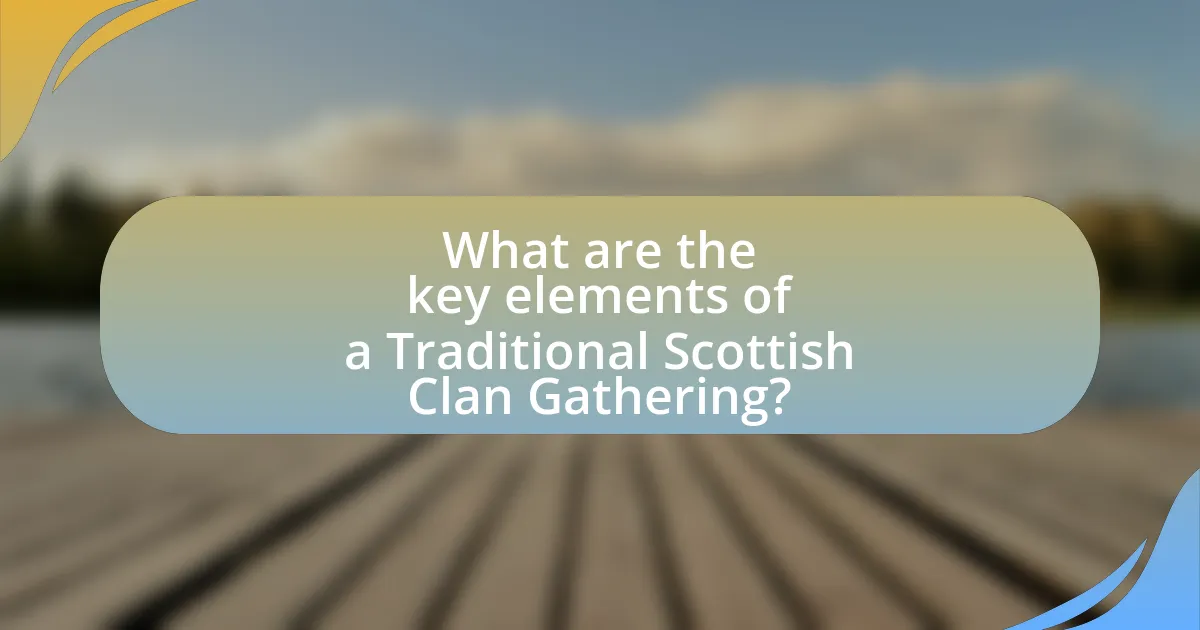
What are the key elements of a Traditional Scottish Clan Gathering?
The key elements of a Traditional Scottish Clan Gathering include the gathering of clan members, cultural performances, athletic competitions, and the display of clan heritage. Clan members come together to strengthen familial bonds and celebrate their shared ancestry. Cultural performances often feature traditional music, dance, and storytelling, showcasing the clan’s history and customs. Athletic competitions, such as caber tossing and tug-of-war, highlight Scottish strength and skill, while the display of clan heritage includes tartan patterns, banners, and historical artifacts, reinforcing the clan’s identity and pride. These elements collectively create a vibrant celebration of Scottish culture and heritage.
How is the location chosen for these gatherings?
The location for traditional Scottish clan gatherings is chosen based on historical significance, accessibility, and cultural relevance. Historical sites associated with the clan’s heritage, such as ancestral lands or castles, are often prioritized to enhance the connection to lineage. Accessibility is also crucial, as locations need to accommodate attendees traveling from various regions. Additionally, cultural relevance ensures that the gathering reflects the clan’s traditions and values, fostering a sense of community and belonging among participants.
What factors influence the selection of a venue?
The selection of a venue for traditional Scottish clan gatherings is influenced by several key factors, including location, capacity, accessibility, and cultural significance. The location must be convenient for attendees, ideally situated near transportation hubs or accommodations. Capacity is crucial to ensure that the venue can comfortably accommodate all participants, as clan gatherings often involve large groups. Accessibility is also important, as venues should be easily reachable for individuals with varying mobility needs. Additionally, cultural significance plays a vital role; venues that resonate with the heritage and history of the clans enhance the overall experience and connection to tradition. These factors collectively ensure that the venue aligns with the purpose and spirit of the gathering.
How does the location impact attendance and participation?
The location significantly impacts attendance and participation at traditional Scottish clan gatherings by influencing accessibility and cultural relevance. For instance, gatherings held in regions with historical ties to specific clans attract more participants due to a sense of belonging and heritage connection. Additionally, locations that are easily accessible via transportation networks tend to see higher attendance rates; a study by the Scottish Government in 2019 indicated that events within a 30-mile radius of major cities experienced a 40% increase in participation compared to those in remote areas. Thus, both the historical significance of the location and its logistical accessibility directly affect the level of engagement at these cultural events.
What types of ceremonies are held during clan gatherings?
Clan gatherings typically feature ceremonies such as the clan chief’s address, the ceremonial raising of the clan flag, and traditional games or competitions. These ceremonies serve to reinforce clan identity and heritage, often including rituals that honor ancestors and celebrate the clan’s history. For instance, the clan chief’s address often includes recounting significant historical events related to the clan, while the raising of the clan flag symbolizes unity and pride among members. Traditional games, such as tug-of-war or caber tossing, not only showcase physical prowess but also connect participants to their cultural roots.
What is the significance of the clan chief’s address?
The clan chief’s address is significant as it serves as a unifying moment for clan members, reinforcing their shared identity and heritage. During traditional Scottish clan gatherings, the address often includes historical references, cultural values, and calls to unity, which strengthen the bonds among clan members. This practice not only honors the clan’s lineage but also emphasizes the importance of community and continuity within Scottish culture, as evidenced by the longstanding tradition of clan gatherings dating back to the 15th century.
How are traditional rituals incorporated into the events?
Traditional rituals are incorporated into Scottish clan gatherings through ceremonial practices that honor heritage and foster community. These events often feature activities such as the ceremonial raising of clan flags, traditional music performances, and the recitation of clan histories, which serve to reinforce cultural identity. For instance, the participation of clan members in traditional dances and games, like tug-of-war and caber tossing, not only showcases physical prowess but also connects participants to their ancestral roots. Such rituals are essential in preserving the unique customs and traditions of Scottish clans, ensuring that the legacy of their forebears is celebrated and passed down through generations.
What role do clan societies play in organizing gatherings?
Clan societies play a crucial role in organizing gatherings by serving as the primary coordinators and facilitators of events that celebrate shared heritage and identity. These societies mobilize members, plan logistics, and create programs that reflect the cultural traditions and values of the clan. For instance, they often organize annual clan gatherings, which can attract hundreds of participants, fostering community bonds and preserving historical customs. The effectiveness of clan societies in this role is evidenced by the successful execution of events like the Clan Gathering at the Highland Games, where clans come together to showcase their unique identities through music, dance, and storytelling.
How do clan societies contribute to the planning process?
Clan societies contribute to the planning process by fostering community engagement and ensuring cultural representation. These societies organize events that reflect their heritage, allowing members to collaborate on logistics, share resources, and make collective decisions. For instance, during traditional Scottish clan gatherings, clans often establish committees to oversee event planning, which enhances participation and strengthens communal ties. This collaborative approach not only preserves cultural practices but also promotes inclusivity, as diverse voices within the clan are considered in the planning stages.
What resources do they provide to ensure successful events?
Traditional Scottish Clan Gatherings provide various resources to ensure successful events, including logistical support, promotional materials, and cultural programming. Logistical support encompasses venue selection, event scheduling, and coordination of transportation, which are essential for smooth operations. Promotional materials, such as flyers and social media content, help attract attendees and raise awareness about the gatherings. Cultural programming includes traditional music, dance performances, and storytelling, which enrich the experience and foster community engagement. These resources collectively contribute to the overall success and enjoyment of the events, ensuring they celebrate heritage effectively.
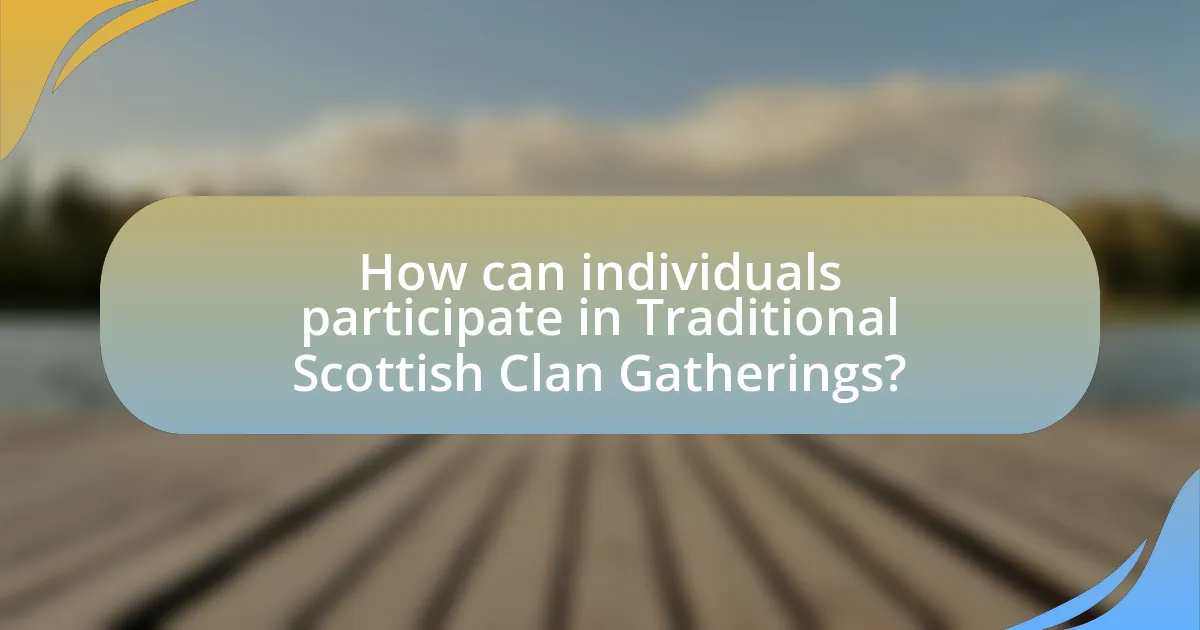
How can individuals participate in Traditional Scottish Clan Gatherings?
Individuals can participate in Traditional Scottish Clan Gatherings by attending events organized by specific clans, which often include activities such as parades, games, and cultural exhibitions. These gatherings typically occur during the summer months and are advertised through clan websites, social media, and local tourism boards. Participation may also involve joining a clan society, which provides information on upcoming gatherings and opportunities for involvement. Historical records indicate that these events have been a part of Scottish culture for centuries, fostering community and heritage among clan members.
What steps should one take to join a clan gathering?
To join a clan gathering, one should first identify the specific clan they wish to join and then reach out to the clan’s leadership or organization. This can typically be done through the clan’s official website or social media pages, where information about upcoming gatherings is often posted. Additionally, expressing interest in clan activities and participating in preliminary events can facilitate membership. Many clans also require potential members to provide proof of lineage or connection to the clan, which can be verified through genealogical research. Engaging with existing clan members during local events or meetings can further solidify one’s intention to join and provide insights into the clan’s culture and traditions.
How can individuals find their clan or heritage group?
Individuals can find their clan or heritage group by researching their family history through genealogical records, DNA testing, and connecting with local or online clan societies. Genealogical records, such as birth, marriage, and death certificates, can provide insights into family lineage and connections to specific clans. DNA testing services, like AncestryDNA or 23andMe, can reveal genetic ties to particular regions or clans, helping individuals identify their heritage. Additionally, joining local or online clan societies, which often have resources and networks for members, can facilitate connections with others who share the same heritage, further aiding in the discovery of one’s clan.
What are the requirements for participation in these events?
Participation in traditional Scottish clan gatherings typically requires individuals to have a connection to a specific clan, whether by lineage or affiliation. Many events also encourage attendees to wear traditional clan attire, such as kilts or tartans, representing their clan. Additionally, some gatherings may require prior registration or ticket purchase to manage attendance. These requirements ensure that participants honor the heritage and traditions associated with their clans, fostering a sense of community and belonging.
What tips can enhance the experience at a clan gathering?
To enhance the experience at a clan gathering, participants should engage in traditional activities such as storytelling, music, and dance, which foster a sense of community and heritage. These activities not only celebrate the clan’s history but also encourage interaction among members, strengthening familial bonds. Historical evidence shows that storytelling has been a vital part of Scottish culture, preserving clan narratives and values across generations. Additionally, incorporating local cuisine can create a shared experience that connects attendees to their roots, as food plays a significant role in cultural identity.
How can attendees prepare for the cultural aspects of the gathering?
Attendees can prepare for the cultural aspects of the gathering by researching the specific clan’s history, traditions, and customs. Understanding the clan’s unique heritage, including its tartans, crests, and historical significance, allows attendees to engage meaningfully in the event. For instance, familiarizing oneself with traditional Scottish music, dance, and food can enhance the experience and foster connections with other participants. Additionally, learning basic Gaelic phrases can demonstrate respect for the culture and facilitate interactions. Engaging with resources such as clan websites, historical texts, or local cultural organizations can provide valuable insights and context for the gathering.
What etiquette should participants observe during the events?
Participants at traditional Scottish clan gatherings should observe respectful behavior, including dressing appropriately in clan tartan or formal attire, engaging in polite conversation, and showing respect for clan traditions and ceremonies. This etiquette is essential as it honors the heritage and values of the clan, fostering a sense of community and belonging among attendees. Observing these practices ensures that the event remains a dignified celebration of cultural identity, which is vital for preserving the significance of clan gatherings in Scottish heritage.
